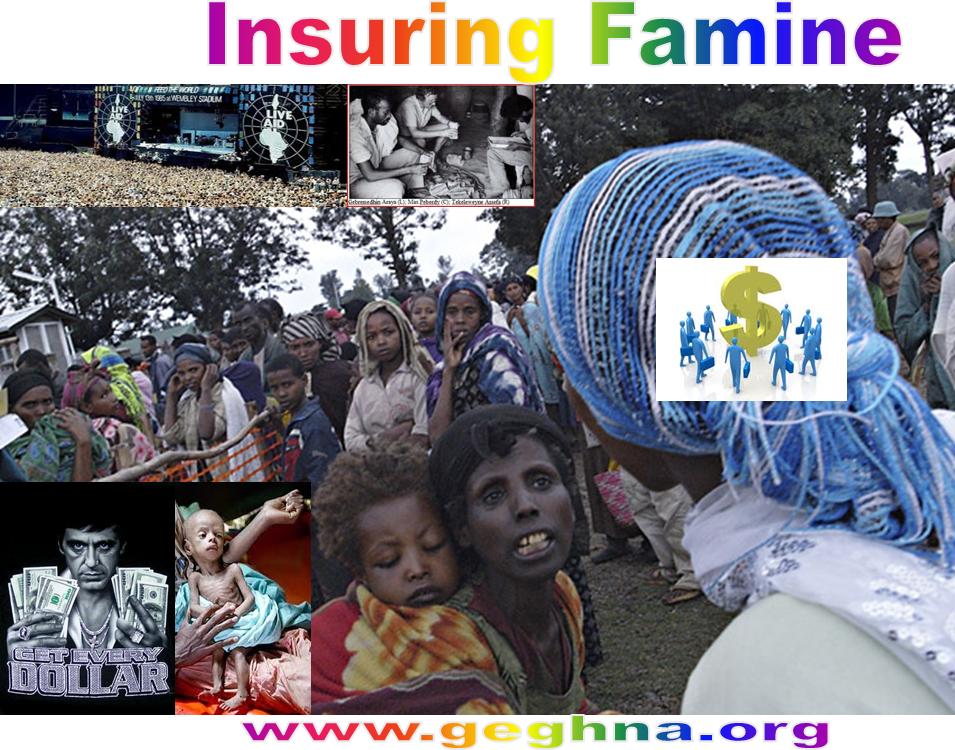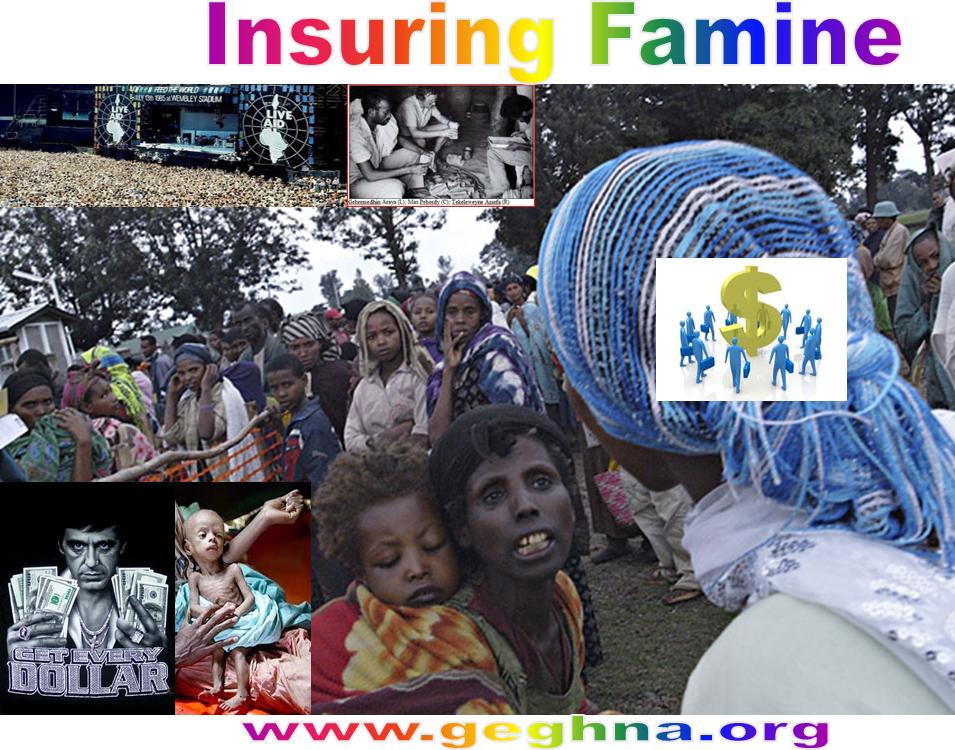The World Food Program WFP has wrongly believed that the so called famine assurance is the way out from drastic famine in Ethiopia. In contrary to Band Aid’s mid 80’s unsuccessful direct aid approach, WFP engaged a business type marketing methodology by Insuring against hunger (IAH). This supposedly in turn eradicate famine from the the Horn of Africa nation by stopping from arriving chronically by taking out weather insurance policies on behalf of starving subsistence farmers.” Even weather in the horn of Africa is impressible. WFP wrongly advocates this will end the ad hoc nature of aid thus working against a government merely surviving through famine aid even from its inception in the famine camp during struggle in 1980’s.

Insuring against hunger (IAH) is a timely profit making on the name of food Aid in Ethiopia. Starting from Band Aid who did not try to make money on the name of the starving in Ethiopia ? And IAH will not be a new phenomenon for the Ethiopian starving dry bones. According to IAH group , the program is effective by indexing the assurance of famine to the Ethiopian weather variations which turn triggers the so called payouts for the starving population. Since the most destructive variance occurs early in the growing season, the so call assurance money making assessment can take place well before the harvest how much money its will make. As the confirmed by IAH itself the pastorals are not assured since there is no predictable rain fall in the pastoral areas that is the reason given by the IAH. The truth is that the pastorals does not own land and they are nomadic types,thus one could not grab their land in case of a catastrophe or non payment. While the settled ones IAH could easily take over their land and make them a slave worker in their won farms with the help of dictatorial regime of Melese Zenawie . The so called promise for the future ” remote sensing of vegetation to include pastoral areas ” is just an empty promise. It has been over 5 years now nothing has been done (2005). The pilot IAH has a tribal and regional profile in Ethiopia, since it has been selectively done in region 1 the region of the ruling dictator.
[media id=73 width=320 height=240]
5 years after IAH in 2010 over over 14 million people in Ethiopia are going hungry
Can commercial practices like risk management prevent famine? This the Question to the new manager of the World Food Program who thinks so and is turning to business to revolutionize aid, we are addressing ?
Could World Bank finance over 80% of the population in Ethiopia, who are farmers from the population of over 80 Million to be assured by the future donation when famine strike?
One thing is sure that as we have seen in the last three governments in (Imperial, Communist, Irridentist) type of government in Ethiopia famine has struck and is striking and will strike a Ethiopia unfortunately. As consequence the Wold Bank and WFP better index not on the weather but on the famine itself, if IAH group are investing to make money in Ethiopa. So the IAH will be sure of its bit. The assurance company will be well assured then rather than indexing the climate, since the weather is not the problem in Ethiopia today. There is ample of rain but there is still famine.
The only way to eradicate the Ethiopian famine is to establish a democratic system of government with a free press and democratic uncorrupted institutions as proposed by Nobel Prize laureate Amartya Sen. This is the only way out with out we have to stop betting around the bush and all effort to stop famine in Abyssinia is a nightmare with a dictator on power.
The theory set by Amartya Sen is the best solution for Ethiopia:_

“It is, thus, not at all astonishing that no substantial famine has ever occurred in any independent country with a democratic form ofgovernment and a relatively free press. Large famines have occurred in authoritarian colonial regimes (as in British India), in repressive military regimes (as in Ethiopia or Sudan in recent decades), and in one-party states (as in the Soviet Union in the 1930s, in China during 1958-61, in Cambodia in the 1970s, or in North Korea in very recent years). Even though the proportion of the national population that is affected by a famine rarely exceeds 10 per cent, which may be electorally unimportant, yet public discussion of the nature of the calamity can make it a powerful political issue.”
The Sveriges Riksbank Prize in Economic Sciences in Memory of Alfred Nobel 1998
Amartya Sen
[media id=74 width=320 height=240]
[media id=75 width=320 height=240] 2007
[media id=76 width=320 height=240]2010
media id=76 width=320 height=240]
httpvhd://www.youtube.com/watch?v=UKY0w1EKe4E&feature=player_embedded 1
httpvhd://www.youtube.com/watch?v=IVAFFKoqZOw&feature=player_embedded 2
[media id=86 width=320 height=240]
Academics call for climate insurance role at Mexico Summit …
